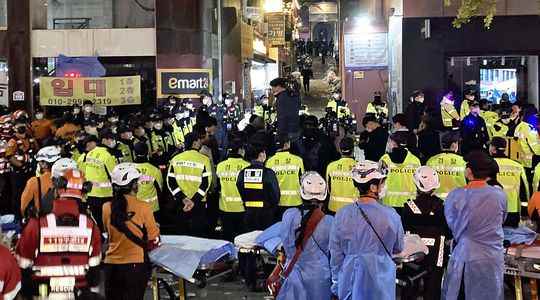A crowd that shrinks, and leaves behind hundreds of people on the ground, between life and death. Rescuers and volunteers, in line, trying to resuscitate them. What happened in Seoul this Saturday, October 29? The party was in full swing in Itaewon, a lively district in the center of the Korean capital, when the worst happened. More than 150 people, mainly young people who came to celebrate Halloween in costume, died in a mob. South Korean President Yoon Seok-youl has declared Sunday a national day of mourning.
- How was the evening before the tragedy?
Some 100,000 people, according to media estimates, converged on Saturday evening on Itaewon, a cosmopolitan district made famous in 2020 by the Korean television series “Itaewon Class”. The occasion was unmissable: the inhabitants of Seoul had not been able to celebrate Halloween since the Covid-19 pandemic. Traders who have been in the area for around 30 years told AFP that the crowd was of an “unprecedented” size.
- How did the crowd rock?
Videos posted on social networks show the crowd very dense but initially calm, before suddenly succumbing to panic. On Twitter, eyewitnesses said they saw people “falling like dominoes”, on top of each other, down a steep, narrow alley. “People in the back were pushing and pushing because they had no idea what was going on up front,” witness Jarmil Taylor, 40, told AFP.
According to the latest count, 153 people are dead and 134 injured. The majority of those who died were young women in their twenties, authorities said. The victims died crushed, trampled or suffocated by the crowd in the alley. According to experts, death in a crowd movement most often occurs by suffocation. Footage on social media showed hundreds of people huddled and motionless in the alley as rescuers tried to pull them out.
- What is the origin of this sudden change in behavior?
The trigger for the stampede has not yet been established. Pending an official explanation, the rumors exploded. Some local media speculated that a celebrity presence at a bar in Itaewon sparked a rush of onlookers. Other online rumors explain the tragedy by a gas leak, a fire in a discotheque or even a distribution of “candy with drugs” in the crowd.
So many rumors denied by the police. Experts warn that the cause of the crowd movement is probably much more prosaic: the authorities’ lack of planning and control measures. Criticisms emerged over the lack of police personnel and the slow pace of rescuers, who struggled to access the crowded alley. A delay that could prove fatal for victims of cardiac arrest, which causes irreversible brain damage or death within minutes.
- How did the government react?
“My heart is heavy and I struggle to overcome my grief.” In his address to the nation, South Korean President Yoon Seok-youl regretted a “tragic” event that “should not have happened”, and promised to “do everything so that it does not happen again”. Opposition leader Lee Jae-myung said he was “shocked” and “devastated” and called for “prompt identification of victims and support for bereaved families”. As for the leader of the People’s Power Party, Chung Jin-suk, he asked “to establish precisely the cause of the accident”. In France, Emmanuel Macron also expressed his emotion. This crowd movement is among the deadliest of the last ten years, behind that which occurred in 2015 in Mecca, which had killed 2,300 people.
- Why are the organization and the authorities implicated?
In documents published two days before the tragedy, the police had indicated that they intended to deploy only 200 officers in Itaewon. Police expected crowds in the area to be similar to previous Halloween celebrations, Interior Ministry Lee Sang-min said. At the same time, according to him, a “considerable number” of law enforcement officers were mobilized to supervise a large demonstration in another part of the city. “It’s a man-made disaster, triggered by a lack of safety awareness,” said Shin Dong-min, a professor at Korea National Transportation University. “Itaewon traders and government officials should have been more prepared for the coming of a massive crowd.”
On the rescue side, teams of rescuers in insufficient numbers experienced the worst difficulties in assisting a very large number of victims in cardiac arrest. Simple passers-by were used to perform cardiopulmonary resuscitation on unconscious people. Video circulating on Twitter showed dozens of people performing CPR on victims lying on sidewalks and others, sometimes dressed in their Halloween outfits, evacuating bodies by carrying them on their backs.
On Twitter, a person posing as a nurse also reported that some patients simply filmed her with their phones, without intervening, while she tried to resuscitate victims. “I couldn’t hold back my tears, no one was helping me, they kept filming,” she testified. “The victim did not survive. This situation was shocking and frightening.” Operators like Kakao Talk and Twitter Korea have urged people to stop sharing shocking images of the disaster.
